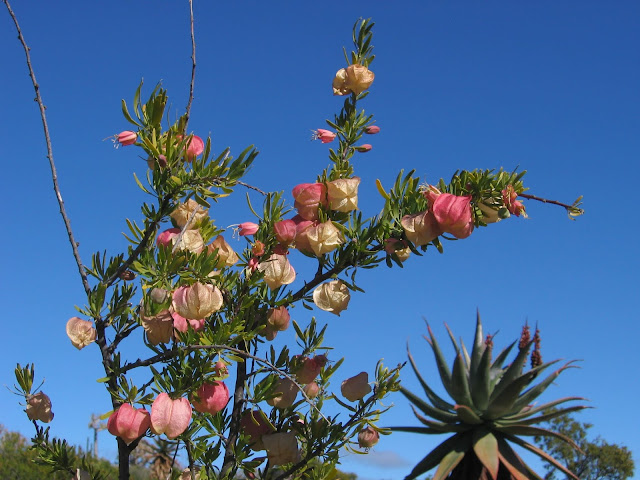Chinese Lantern lights up the African desert
This single plant caught my eye both times I visited the Karoo Desert National Botanic Garden, in August of 2005 and then the same month in 2018.
It's called Nymania capensis, the sole species in this genus, and as the species name suggests, from the southern tip of Africa. It grows naturally from southern Namibia through into South Africa, to the Little Karoo. Karoo Desert National Botanic Garden is near Worcester, part of its natural range.
In English its most common name is, appropriately, Chinese Lantern. There are other local names such as Klapperbos and lanternbos ('klapper' is Afrikaan for firecracker, and 'bos' means forest - local kids apparently enjoyed popping the fruits).
In nature it grows in hot, dry, rocky areas, like where it is growing here, but also near dry, sand rivers. The plant is recommended in South Africa for dry areas with cold winters. It tolerates frosts down to -4 degree C and daily maxima of up to, and above, 44 degrees C. So it would do OK in much of southern Australia (my colleague Peter Symes tells me they have one growing in Adelaide's city botanic garden).
It grows slowly, mostly in winter when rains arrive. Ian Oliver, writing for the South African Biodiversity Institute, says even under the best conditions it may take three years to reach a metre and a half in height. In nature they can live for more than 25 years but you seldom see photos of them much bigger than this. Oliver says they can get to six metres tall but are often no more than three.
The brown seeds are held inside an inflated, papery fruit that is transported mostly by wind (tumbling along the ground mostly) or water. I haven't found any evidence of it becoming weedy but then it is seldom grown in horticulture.
While this is sometimes attributed to them being difficult to germinate (which would happily control its further spread outside gardens), others say they germinate 'readily'. Transplanting may be the problem and care needs to be taken to not disturb the roots.
If you look at the flower it has about eight stamens (the male bits, ending in pollen-containing anthers), connected at their base. This is typical of its botanical family, the Meliaceae, which also includes Mahogany (Sweitenia species), Neem (Azadirachta indica) and our own White Cedar (Melia azedarach).
Apart from attracting visiting botanists, the plants has some practical uses. The leaves make good fodder for local stock and the roots contain a rennin used to curdle milk. Both the leaves and the root extract are used locally as a medicine and to treat wounds.
While this is sometimes attributed to them being difficult to germinate (which would happily control its further spread outside gardens), others say they germinate 'readily'. Transplanting may be the problem and care needs to be taken to not disturb the roots.
If you look at the flower it has about eight stamens (the male bits, ending in pollen-containing anthers), connected at their base. This is typical of its botanical family, the Meliaceae, which also includes Mahogany (Sweitenia species), Neem (Azadirachta indica) and our own White Cedar (Melia azedarach).
Apart from attracting visiting botanists, the plants has some practical uses. The leaves make good fodder for local stock and the roots contain a rennin used to curdle milk. Both the leaves and the root extract are used locally as a medicine and to treat wounds.






Comments